JDS Labs Atom Amp
JDS Labs has been the face of Objective audio throughout the decade. To us, making headphone listening enjoyable starts with honest designs in which measurements come first. Make no mistake: We do not create to be another car on a hype train, or for the sake of a predictable release schedule, or for revenue targets. Worthwhile releases must bring more to the table than specifications.
We’re proud to share that Atom Amp is our new best amplifier. We built it to outperform Objective2 in every way: better specifications, greater power, higher reliability, and more input and output flexibility. Atom Amp ships standard with a 1/4in headphone jack, an integrated dual-input preamp (selectable RCA and 3.5mm inputs), and RCA preamp outputs. All controls are front mounted, and the knob is backlit so Atom Amp looks awesome on your desk. It’s only $99 USD.
Hardware Overview
 PCB Layout
PCB Layout
Atom Amp adopts a new JDS Labs board layout philosophy. I ran into a wall with respect to noise performance of several prototypes last year. New circuits were measuring no better than older circuits using our standard PCB stackup.
To push performance to the next level, Atom Amp’s AC rectification stage is physically isolated from its amplifier stage at the PCB level, like two boards in one. Linear DC rails and ground connect to the amplifier in a star fashion, improving noise performance by more than 10dB relative to ordinary 4-layer stackups.
Amplification Stage
Atom Amp is DC coupled throughout. It’s been a long time since I encountered a source with DC offset. Consumer audio players are often AC coupled, and all JDS Labs DACs are DC coupled with insignificant DC offset.
The amplifier is powered by +/-15VDC rails derived from internal AC rectification. Our standard 15VAC 500mA transformer was suitable for most listening, but we’re shipping Atom Amp with our larger 16VAC 1000mA supplies. The extra transformer capacity helps drive demanding sets.
Atom Amp’s gain stage accepts up to 2.1VRMS input at high gain of 4.5x, or you may listen at unity gain (1.0x) with sensitive headphones. A custom Alps 9mm potentiometer with 15A taper ensures excellent channel balance. Clean output buffers deliver more power than a vast majority of listeners will ever need.
Relay Muting
Hardware relay muting enables audio output after a one second delay, to avoid startup pops and thumps. Muting applies to both the headphone output and preamp outputs.
Integrated Preamp
Atom Amp essentially replaces the need for pairing OL Switcher with Objective2. The Input button selects between RCA or 3.5mm input, so you can connect two different audio sources and switch between them as needed.
The RCA preamp outputs mute while headphones are connected. Output volume is controlled by Atom Amp’s knob.
Benchmarks
Measurements were taken using RCA-to-BNC and TRS-to-BNC cables to a Prism dScope Series III Audio Analyzer. Atom Amp was powered by a JDS Labs 16VAC 1000mA transformer. Test load for all screenshots below is 150 ohms at 1.0x gain. We also conducted all measurements at 32 ohms and 600 ohms. As results are remarkably similar to look at, we’ll leave further analysis to the community. Maximum output power is observed at high gain, of course.
| Measurement | Unit | |
| Frequency Response (20-20kHz) | +/- 0.01 | dB |
| THD+N (20-20kHz) 32 Ohms | < 0.0012 | % |
| THD 1kHz 32 Ohms | 0.0008 | % |
| IMD CCIF 19/20kHz | <0.0002 | % |
| IMD SMPTE | < 0.0005 | % |
| Noise (A-Weighted) | -114 | dBu |
| Max Output @ 32 Ohms | 1001 | mW |
| Max Output @ 150 Ohms | 502 | mW |
| Max Output @ 600 Ohm | 126 | mW |
| Output Impedance | 0.7 | ohm |
| Crosstalk (1kHz, 150 ohms) | -87 | dBu |
| Channel Balance (50% volume) | < 0.6 | dBu |
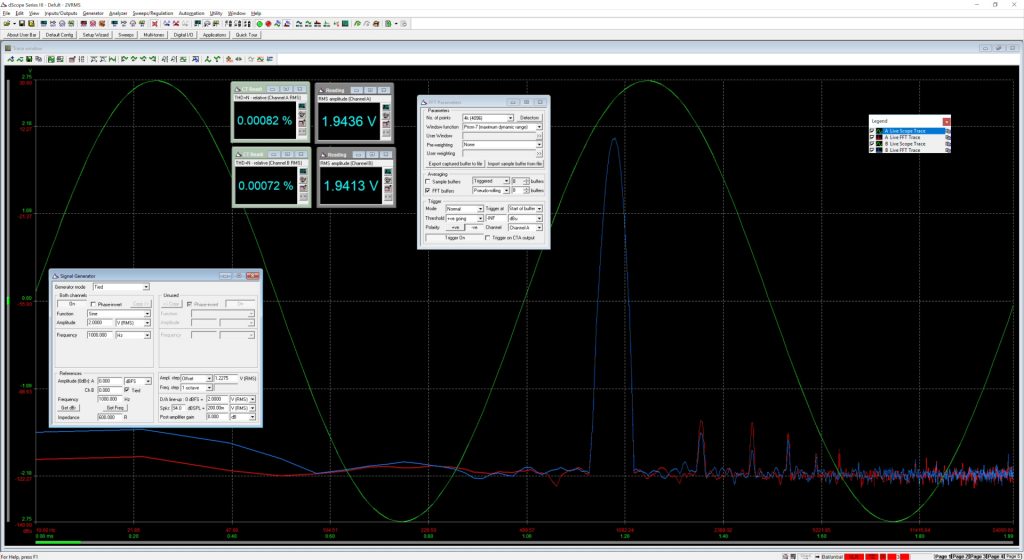
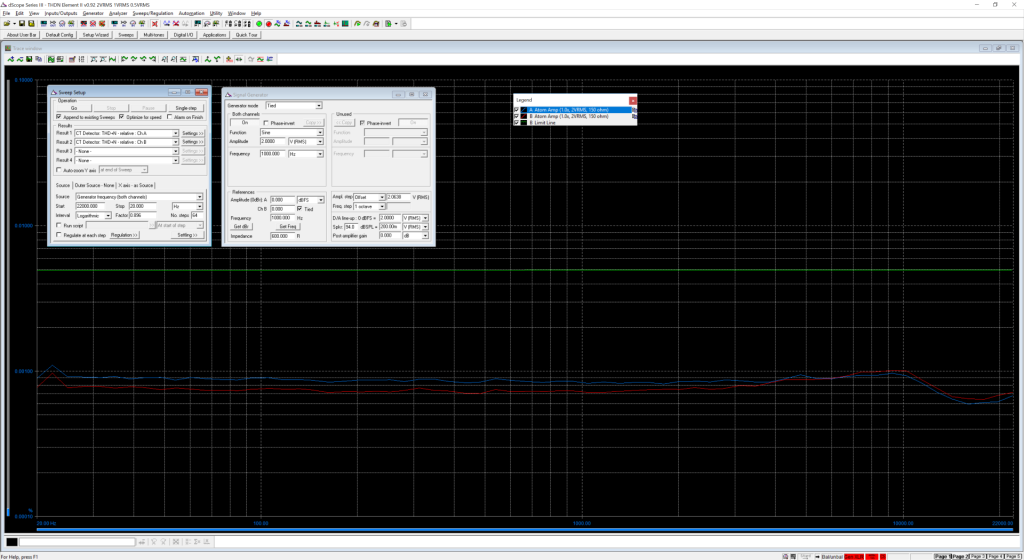

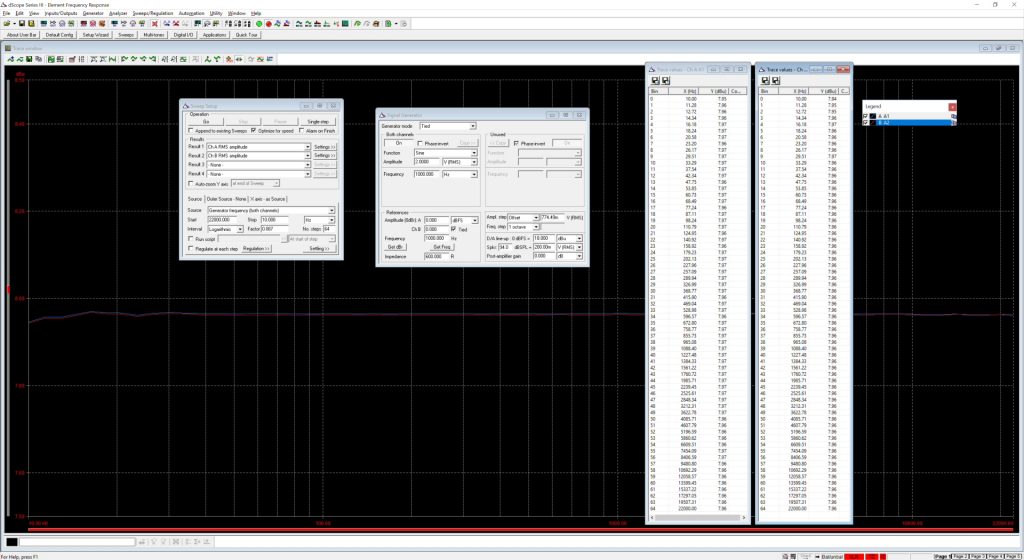
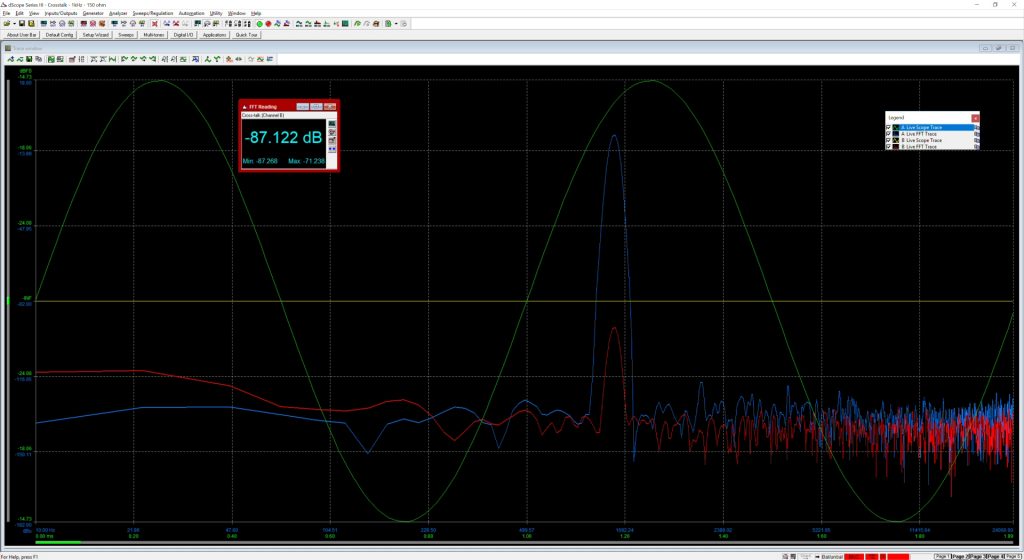
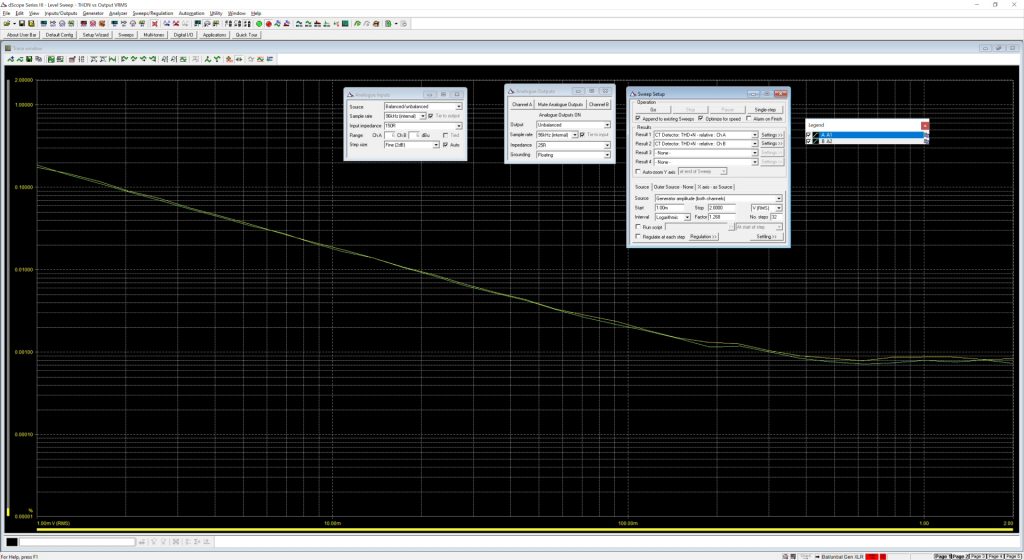
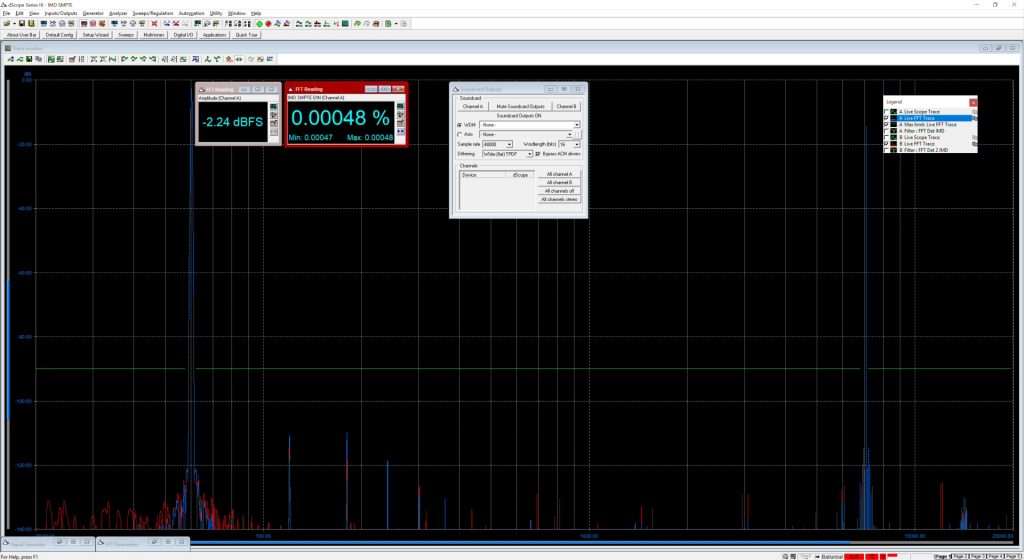
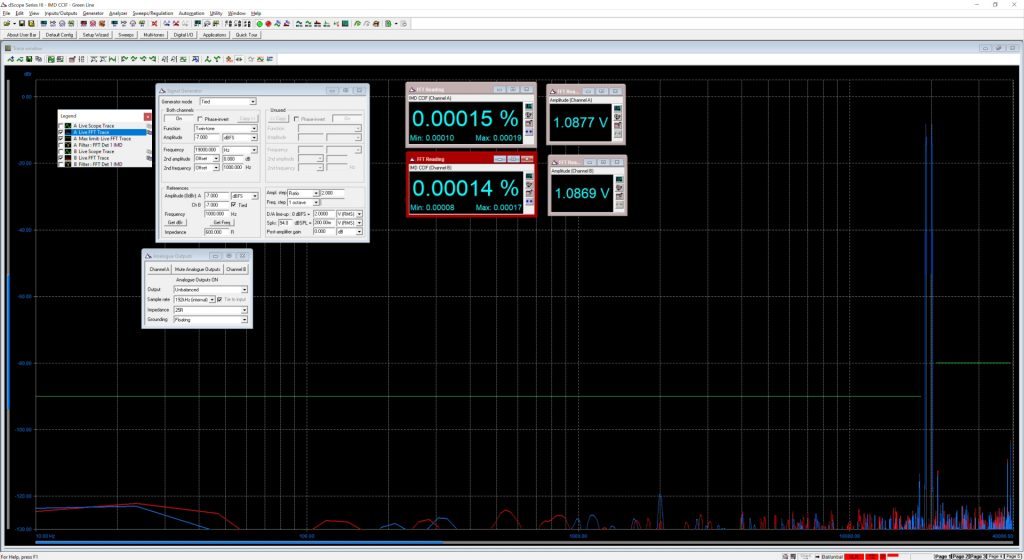
Production Banter
Atom Amp is our first all injection molded assembly. Because we primarily create aluminum enclosures at JDS Labs, we proceeded with caution, meaning one design at at time. Fortunately, Atom Amp fit together smoothly thanks to our production partners and the power of 3D printing.
OL DAC and EL DAC stack well with Atom Amp for now. As always, we’re listening to your feedback!
Engineering samples of Atom Amp were sent to customers and insiders throughout the year for feedback. As we wrapped up testing and initiated v1.00 production, I handed a first-article board to our intern for a listen. A few minutes later, he reported reversed L/R channels via 3.5mm input. I listened. Yep, left and right channels were backwards. How had industry experts and I missed this?! Easy: We all use RCA input. Our team spent a week manually correcting pinout of the 3.5mm input on the entire batch of production boards. Performance, appearance, and functionality are all the same. I only share, as anyone who performs a detailed teardown may ask.
Being injection molded, Atom Amp weighs about 9 ounces. We added internal weights in the corners to better balance the chassis on your desk. Early reviewers enjoy the amp’s feel. That said, weight can be customized as needed and we’ll listen to your feedback.
Reviews
Atom Amp is in the hands of several reviewers and we look forward to seeing more community feedback in the coming days.
Links will be added and updated as they become available at:
- Audiosciencereview.com
- Head-Fi
- YouTube – Best $100 Amp? JDS ATOM – REVIEW (DMS)
- Other audio publications
Don’t see your favorite outlet? Ask your favorite reviewer!
Availability
Atom Amp is IN STOCK at the time of this posting. We will ship upon arrival of packaging on Wednesday, November 21.
Quantities are limited by the number of 16VAC power adapters in our inventory, and we expect Atom Amp to sell out rapidly. More AC adapters will arrive early December. Inventory status will be updated here as well as on the Atom Amp product page.
Let us know if you have any questions!
Availability Updates
- Friday, Nov 16 Update: Wow, we’re blown away! Thank you to all who adopted Atom Amp within the first 24 hours. Your order will ship by Wednesday, Nov 21.Atom Amp will remain listed as “Backorder” until our next batch of AC adapters arrive in early December. Orders placed with
Australian (AU)[AU sold out Dec 6] or British (UK) power adapters may ship sooner, while most US and EU orders will be fulfilled early December. - Tuesday, Nov 27 Update: Many thanks to everyone who has supported Atom Amp thus far. We’re off to a crazy start! Production of a second batch began yesterday. We’re actively working with our partners to keep the supply chain running smoothly.AC power adapters are scheduled for shipment to JDS Labs on Thursday, Nov 29th. Freight shipments typically arrive in about 1 week. Barring any freight delays, Atom Amps will continue shipping in early December.
- Tuesday, Dec 4 Update: US and EU Power adapters arrived ahead of schedule and we’re on schedule to ship all backorders within the next 1-2 days. Atom Amp stock is quickly vanishing due to high demand, and may be sold out by late December!
- Monday, Dec 10 Update: The first batch of Atom Amp boards have sold out (thank you!). Batch #2 is being assembled this week, and we hope to resume shipping by December 20th.

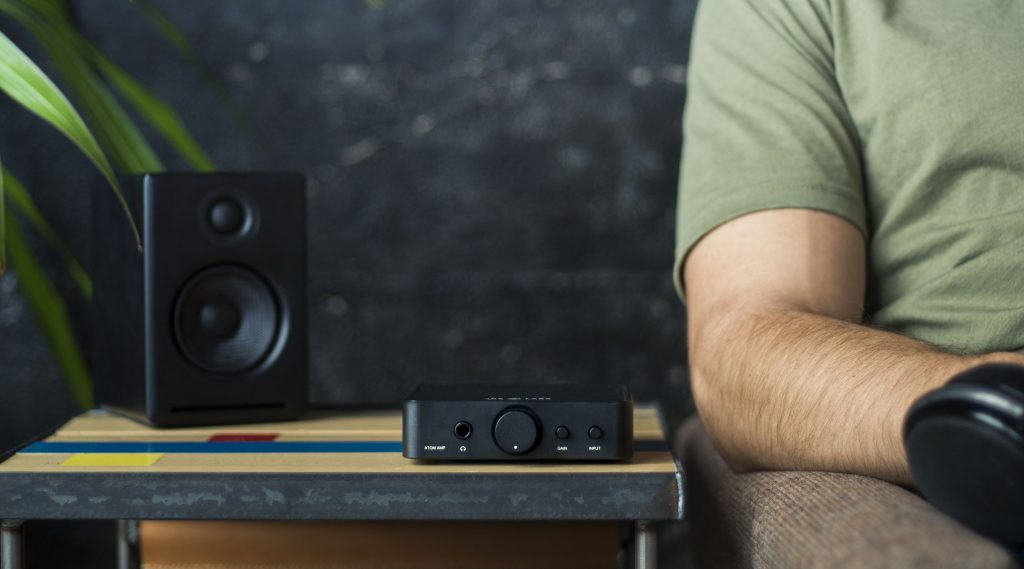
This looks brilliant! Any chance of getting a DAC in a matching case for nice stacking?
The only change I’d want is a power button. I switch between speakers and headphones a few times a day and a button to select headphone out VS rca out would be perfect. Having to hold the amp with one hand and pull the cable with the other is just a tiny aesthetic annoyance. First world problems eh.
Thanks, @Cory! Market leading designs take time, and we’re always experimenting. That’s all I can say for now.
Have you guys considered balanced XLR in a future dac and/or amp? 🙂
Thanks for the feedback!
Hi Jonh, I ordered the JDS Labs atom and the OL-Dac, but I dont know what is in the box. Do I have to order cable or its in the box? Its for my PC, I want to use it with my headphone. Thanks 🙂
Sorry for my English, its not my main language.
Hey Mike!
Thanks for ordering the Atom and OL DAC! The OL DAC will come with a USB cable in the box, but you will need to get an RCA cable to connect the OL DAC to the Atom amp. You can find a couple RCA cable options in our store.
Don’t hesitate to email if you have any other questions.
Thanks for reaching out!
Performance-wise this Atom Amp is perfect!
Given its size and weight it can be still regarded as very transportable. If it can be used without the need of an AC plug (e.g. with internal rechargeable battery or being able to use USB power) this will be a big plus. I am willing to pay more if it has a nice metal body like the Element as well.
Looks fantastic, John! What colour is the LED behind the volume knob? Would there be any way to add an engraving like with the Element?
Good questions! Atom Amp’s backlighting is cool white.
Engraving requires anodized aluminum, so custom artwork must remain exclusive to our aluminum amps and DACs.
Noted! Thanks John.
Crosstalk and channel balance specs in dBu? Seems legit. 😉
Very interesting little beastie, I’ll definitely keep an eye on it.
When is the DAC Atom coming out. I need a new stack for my offitdesk.
I’d like to know that as well. ?
Hopefully soon enough a DAC with the Atom design language is released and it being equal or better than the Schiit Modi 3 which showed exceptional performance for a $99 device as did the Atom on Amp territory. Also I suggest the DAC to be named Neutron as it should be neutral and is also part of the nucleus of and atom, so hopefully I get a cookie or better still a free DAC when available!
Please be first quarter 2019. I want to buy the atom but want a matching dac as well. Even better if you guys have an all in one atom dac/amp. PLEASE
I want a DAC with -115dB thd+N to pair with this atom, please bring it to the market! hopefully less than $400
How about making one $199 amp with balanced xlr in and balanced xlr out?
Can the preamp-out (input select and volume control) work without the power supply? Is the preamp having gain?
@Jimmy: Preamp outputs are active, and require the power supply. Use the 1.0x gain position when using preamp output; this eliminates gain.
Just for a clarification here. Why do we need tohave the amp to have 1.0x gain if that is supposed to beno gain at all. What’s the difference of the music through no gain at all? Would it be better to don’t use an amplifier at all? I always add the gain, that’ s why I purchase amplifiers!
Gain of 1.0x buffers the audio signal. The source is presented with a high impedance load (the amplifier input instead of a demanding headphones load). This generally means an improvement in THD. Background noise also improves, as the source signal is attenuated.
If the source presents high output impedance, the amplifier corrects this deficiency, resulting in more natural frequency response.
All of these improvements aside, you’re welcome to use high gain, but there is no reason to do so unless you need the additional volume.
My high impedance 2 headphones, a Sennheiser HD650 and a Hifi-Man 4000 don’t like to “play” as they should with even the high power, music can be heard but they lack the punch to yield a real musical presence. The O2 amp has the maximum gain as specified in the manuals, and I am very pleased with it. Recently I bought a case and some parts to finish a second one that I will use in a portable way. Thanks for the reply, now I understand why it is not just plain gain the 1.0x has, and I have noticed something like what you say in your reply to me. Being myself a technician, I know that you must not use the input to max volume, as distortion is worse at max volume. Then, if you give more gain to the amplifier, the music has less distortion. However, at the low or almost unnoticed distortion of the modern audio chips that should not be a problem here. I remember the catastrophic distortion of the tube amplifiers. Thanks
Hi John,
I have the Sennheiser HD6XX headphones and listening to Amazon streaming music through my macbook and Samsung S9 phone. I really enjoy the headphones with the loud volume (70%). But I when turn the volume down to 40%, I don’t hear much detail and clarity. So, will the amp help with that? Can I hear and enjoy the same quality at low volume when using the amp ?
Another question is my main source of music is online streaming. Will the amp or dac/amp bring huge benefit to the performance?
Thanks
Hiru – You’re likely describing this effect: https://en.wikipedia.org/wiki/Equal-loudness_contour
In short, your ears perceive audio differently at low volumes compared to high volumes. An amplifier will not help if you wish to listen at low volumes. Applying a software “loudness” function would be necessary to experience the same effect at low volumes.
An amp and DAC should improve dynamic range and max volume. While there are other benefits, streaming audio will be a bigger limitation. I would not anticipate a”huge benefit unless you listen at higher volumes.
Given this is DC coupled – is there any DC offset protection? Or any protection circuits beyond the muting relay to protect headphones from damage?
None present; we have shipped thousands of DC coupled amplifiers in the past similarly.
You can detect DC offset of any amp by listening for a large pop when changing gain, or severe noise when turning the volume potentiometer. If either happens, it’s a good idea to check your source for offset. We’ll add these suggestions to the Instructions guide. Thanks for your thoughts.
I am interested, but I own the Element already. Is it any better if I get an Atom Amp?
Element is in transparent territory, so while Atom sets record measurable performance, I see no reason to swap. Enjoy what you have!
Element’s larger PCB surface area gives it an edge in thermal disspation over long duration high power listening (read: ear damage). Atom reaches 1W easily, but does not compete with the 1.5W bursts I was able to hit with Element. Probably lucky for us, as Element v1.53 remains relevant for this reason. That being said, I have reservations advocating more power. Check our Power is Volume article from 2015. Headphone manufacturers are increasingly releasing more efficient drivers, so the case for more power is declining.
The new Atom Amp looks great!
Like @Cory Nelson suggested, any chance you guys could just put the current OL DAC into a matching case? They would look great stacked together, and I’d definitely get a pair.
Could you please explain the meaning of dBu in the measurements of crosstalk and channel balance? Why is it referenced to 0.775V? Usually this is just a relative ratio measured in dBr (or simply dB).
Is crosstalk measured from left to right or from right to left? Or is it measured in both directions and you state the average or the better or the worse value?
Is it worse at higher (up to 20 kHz) or lower (down to 20 Hz) frequencies? A sweep would be nice!
Besides that, I’m really astonished about Amir’s APx555 measurements. This amp is of incredible high objective measurable quality, especially for its price. How is this possible?
An Atom DAC would be the icing on the cake…
I would love to see a blog post on some of the design process including a discussion of the various prototypes and the process involved to select an optimal design. All of that knowledge is of course your proprietary intellectual property but I think it would be a great resource for the audio community about how audio quality is objectively quantified and how great performance is achieved through good design practices instead of expensive and exotic components. The legendary NwAvGuy post on the O2 amp design has a lot of fantastic information about spec’ing components and layout considerations, but he doesn’t go into much detail about his process for prototyping and his design iterations.
A matching transparent DAC using the ESS 9038Pro would be great.
Hopefully as it happened with the Objective line and NwAvGuy we could have a DAC based on the Khadas Tone Board from WesionTEK which has proved to measure amazing and under $100 for the barebones board, with JDS Labs just adding a case this would make for the best budget combo with the Atom Amp.
@Carlos – The “Khadas” team has done a fantastic job with the Tone Board! Any DAC at this level of performance will cost more than $100 once paired with an enclosure.
Based on the amazing response to Atom Amp thus far, we know price is an important consideration. What are your thoughts?
@John – I bought the JDS Labs Atom Amp and the Khadas Tone Board (Generic Edition) and they’re simply amazing, what’s missing is still a DAC to pair nicely for stacking to the Atom Amp (Like Massdrop’s THX AAA 789 + Grace SDAC Balanced), and one that looks incredibly well is the Topping D50 with the Atom Amp but it costs $250. However, a kind of joint venture with the Khadas team and JDS Labs I’m pretty sure many budget audio enthusiasts would be very happy to pay around $150 for such a DAC based on the Khadas Tone Board with an enclosure that matches the Atom, and as I said some time before, please name it Neutron! 😉
Here is the D50 + Atom stacked:
https://www.audiosciencereview.com/forum/index.php?attachments/jds-labs-atom-headphone-amplifier-and-topping-d50-dac-jpg.17859/
Oh, and did I say I would buy from JDS Labs a DAC that’s based on the Khadas Tone Board even though I own one for the nicely made enclosure? ;D
Your amp/dac combo was a great choice, I’m thinking of buying the same it would be great to talk to you about it.
+1 for a Khadas Tone Board in an Atom enclosure. Just as good would be an OL DAC in an Atom enclosure. An Atom DAC/Amp would work as well. I just like a clean looking stack.
can this have engraving on it? i plan to buy this in a few weeks and i want engraving on it..
lior – Engraving is only possible on aluminum surfaces (Element and Objective amps and DACs).
I really like the design language of atom. Have you ever thought that maybe you could work with Khadas and make a beautiful dac+amp?
Any news yet on the possibility of an AtomDAC to supersede the o2dac?
Wish I could share more! We keep R&D efforts tight-lipped…
Many Atoms are missing a Neutron (or Nucleon if considering protons too) for a DAC 😉
Do you guys have a newsletter to be alerted of eventual development? 🙂
Hey Arthur! We do not have a newsletter, but we do post all new announcements to our Twitter and Facebook feeds.
Could you add a ” ⅡS Over HDMI ” to the coming ATOM DAC?
I just bought the Atom since the difference between the THX 789 and this is so minimal, it is just not worth paying for it. The Atom will be a worthwhile upgrade from a certain Objective2 Booster Board that I received within the two years. 😉 I will also add my voice to the others out there that I would gladly pay for a JDS Labs-branded Khadas Tone chassis. Heck, if you could even provide machined front panels to use with the B2-080, that would be a huge service for those of us who don’t have drill presses and other fancy machining equipment.
Yes good suggestion on a JDS case for the tone board. I’d be happy with a 3D printed plastic one for cheap to match the Atom.
I just ordered an Atom and an hemming and hawing over ordering a tone board for it or waiting for the inevitable Atom DAC.
You can get the Khadas Tone Board for a low price here in the USA now at Digikey if you are likely put aback by the delivery time and shipping charges. I have my Tone Board in toe with my Atom and the sound is breathtakingly exquisite. Quite literally, I have not heard anything this clean even in the exorbitant kilobuck top-of-the-line (TOTL) price range and I subjectively hear a substantial improvement from the ODAC/O2 setup I used to have. For years, some waited in vain the yearned for return of NwAvGuy and his mythical ODA that was geared to bring even better TOTL performance in audio fidelity in the low-end price range. Well, for a mere paltry sum of $200, the Atom is the rightfully spiritual bearer of this legendary, never-realized device. Outside of the THX 789 and perhaps the Beta 22 (https://reference-audio-analyzer.pro/en/report/amp/diy-beta22.php), you will likely never find better than this.
*$200 for both the Atom and the Tone Board. Sorry. Early morning flight.
Rather than the tone board, I would like to see what John could do with an AK4490 or AK4493 “Nucleus DAC” in the $99-149 range to pair with the Atom Amp. The Tone Board is good but John is a great circuit designer in his own right. The AK chip should be lower distortion at lower level input signals (no ESS hump). To keep cost down, the DAC could be USB powered with only RCA outs. Doesn’t even need a power LED/switch. Budget permitting, add SPDIF input (either auto-detect or switched), power LED and power switch.
Thanks, Paul. A Tone board is resting on my R&D bench and there it shall stay. We preemptively requested direct pricing from Khadas after Atom Amp launched. Tone was an early consideration for the Atom DAC enclosure based on excitement here and elsewhere.
I’ve held my tongue on this topic for some time now, as it’s generally unwise to comment on other manufacturers’ designs. Khadas is unique in that their boards are intended for implementation by third parties. Only because so many have asked, I owe an explanation why JDS Labs will not stock Tone.
Well, within minutes of evaluating the Tone board, I was too disappointed to consider investing further in this path. From Amir’s testing of dynamic range:
I was shocked to see Tone’s Noise measurements crushed by DACs from 2012 because of its grounding layout (>20dB worse than expected). Khadas made otherwise excellent design choices. I reviewed the Tone schematic and was pleased to see they utilize similar regulation, decoupling, impedance, and ESD protection choices as we implement. The grounding issue is not a concern when using Tone with a headphone amplifier; it potentially raises noise when used with an active preamp and an external system, which is an increasingly common setup. I had to establish a separate analog ground path to see reasonable performance. The only other DAC requiring this accommodation was a reference board I tested years ago. Tone’s USB regulation is good, not perfect. The USB ports on my Ryzen test rig are noisy, and Tone measured about par with our aging OL DACs in terms of THD+N. Last, the USB Type C port intermittently disconnected. Rotating the cable 180 degrees solved (bad luck?). Still, these are not the kinds of experiences I want to pass along to JDS Labs customers.
All of that being said, Tone performs well in areas like jitter and linearity. As a standalone board, no FCC/CE certifications are provided. A pre-EMC check on our spectrum analyzer shows low radiated emissions, thus, anyone implementing Tone should have no problem obtaining FCC/CE certification.
As for powering DACs via USB, I respect the choice and cost savings of eliminating a power adapter. We sold ODAC and ODAC RevB for years this way, and it generally worked well. HiFi audio is a luxury. Manufacturers need to raise the bar, and I believe a dedicated AC transformer is the right choice.
Actually, looking at the OL DAC, it is great that you got what you did in there for the price you did with the external power. Perhaps you could start with that as the design for the Atom DAC with the Atom shell to save BOM costs, updated star ground topology to improve S/N ratio, and expiriment if the 4493 measures better than the 4490 in the real world. My main tweak to the OL DAC would be to see if a spdif could be offered in a version or integrated into the base model.
Awesome, informative post!
When could we see the Atom DAC, John?I really hope that you could make JDS’ own DAC instead of just making a case for Tone Board or D50( ॑꒳ ॑ )
I trust U ALL!
PS:a I2S(HDMI version)on the Atom DAC (for an interface ) is sooooooooo welcome
Hi, QT – This year 🙂
Nice! 😀
Looking at the naming, I guess it’s probably gonna be called Atom Dac, while the combined version might be called Isotope? Element then the EL amp/dac.
Really hoping for Atom Dac, with dual dac chip
Really need a gorgeous dac with 4493 & I2S Over HDMI!!!
Why the 4493? If anything they should use the AK4499EQ.
The AK4493 costs ~$6 per unit in medium quantities (~500 units) which is a few dollars more than the AK4490 in the existing JDS products. Several manufacturers have made DACs with exceptional performance with the AK 4493. The AK 4497 and AK4499 are a completely different line-up and cost $40-50+ per chip. There is a reason why they tend to appear in $500+ products. Those chips aren’t in the right market segment to pair with a $99 DAC. I think that John can use an AK 4493 and work on better grounding and probably improve the OL DAC by 5 dB or more in both S/N and THD/IMD and it would be a big win for the Atom DAC.
AK4499 costs over $90 per piece, $50-60 in 100-500 QTY.
So no. 4499 is for the very highest-end.
Hi there – I notice that the AU version of power supply is on backorder. Is there an eta?
Hi, is the output impedance still 0.1ohm if we use atom as preamp? Or the measurement is solely for the headphone output?
Yes, the preamp output specifications are identical to the headphone output. Circuitry is one and the same. The pushbutton selects which jack receives output (6.35mm or RCA output).
Hello! I’m atom amp buyer. Could I know that atom amp is a 50/60Hz Free Product? I live in South Korea so I have to use this through 60Hz/240V. I’m looking forward to your earnest reply 🙂
Hi Chris – Yes, the EU/AU/UK transformers are all rated for 50/60Hz at 220-240VAC.
Thanks for replying 🙂
Just received my Atom and wiring it up. I’ve read through the comments here but I’m still a bit uncertain – if I connect my headphones via the rear RCA out is it effectively the same as connecting them to the front 6.35mm jack? The ‘preamp’ part makes it sound like the RCA out bypasses the amp (I’m a novice) but the gain affecting the RCA out would indicate that they’re driven by the amplifier, instead of being a pass-through. Also, the instructions show them being driven by the amplifier. Never hurts to ask though 🙂
In case my request sounds weird, I’d prefer to use the RCA out to drive my headphones because of the way my desk is laid out and wired.
In high gain, my DAC outputs 4Vrms on XLR , i see that on high gain the ATOM can only accept up to 2.10vrms input before it starts distorting.
Use an XLR to RCA cable Converts a balanced audio signal into an unbalanced signal to Atom。
Will there be overload and distortion?
@SPARK: Converting from Balanced to Unbalanced drops the inverting signal, so unbalanced level is half = 4VRMS/2 = 2VRMS. This is a perfect signal level match. You’ll need to refer to your DAC’s manufacturer to understand its THD behavior in unbalanced mode (most likely still excellent).
when will we see the atom dac and atom combo(like the element)?
So I just the Atom delivered to India and I must say I am extremely happy with the price:performance of the product. I have coupled this with a Fiio Q5 DAC via 3.5mm line out to 3.5mm line in on the Atom. Currently using DT 990 pro 250 ohm. I got a question..
I am considering buying the DT 990 Edition 600 Ohm 96 db SPL headphones. Looking at the specs of all the products involved in the loop:
Atom outputs 125mW @ 600 ohms
Fiio Q5 line level is rated at 1.8 Vrms
Dt 990 Edition power handling capacity is noted to be 100mW
I’m wondering if the Atom will be able to power these headphones sufficiently/ cleanly and would get loud enough…
Any insight would be really appreciated.
Thank You
Hi Manas – Glad you’re enjoying Atom Amp! Output power using a 1.8VRMS DAC will be slightly limited:
P = (4.5*1.8)^2/600 = 109mW
Thus, it is possible to drive 600 ohm headphones. But if you are happy with the 250 ohm version, there is little reason to invest in the same headphone with higher impedance. This will only reduce dynamic range.
Hi John. Thank you so much for your input. I was under the impression that getting a higher impedance headphone would yield me even better sound quality and with the atom having power in spades, i was considering a switch.. not that the dt 990 250 ohms sound bad or anything.. wanted something better/ different.
Just another question if you dont mind.. in your opinion, what would be the optimal headphone/s that I could drive with the setup mentioned and squeeze the best out of everything in the loop.
Thank you again 🙂
I bit the bullet and picked up the Bayerdynamic Amiron Home and I must say – WOW!
GG JDS Labs
Hi John,
I bought the Atom and was also considering the Q5s as a desktop dac for when i’m at home. live Manas said, this unit only outputs 1.8vrms. how limiting is that compared to the common 2vrms?
i plan to drive hifiman 400i. In my case, would i feel the limitation of 1.8 vs 2 vrms? because at 35 ohms, amp power output would be more than sufficient for me.
thanks.
1.8VRMS is only a 10% reduction from 2.0VRMS, which will translate to a few decibels. I think you’ll be okay!
thanks mate!! only reassurance i needed